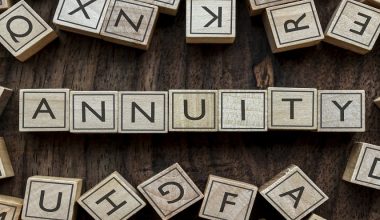The yearly percentage yield on an investment is the annual percentage profit earned when compounding interest is taken into account. It’s a useful metric to have when deciding which bank to use and which account to open to optimize your interest payments. If you grasp the annual percentage yield savings account, as well as what differentiates it from the annual percentage rate and how to use its calculator, you’ll be better equipped to make the most of the money you have in the bank. We covered all of that in this article and much more.
What Is Annual Percentage Yield on Savings Account
The annual percentage yield (APY) is the amount of money you make in a bank account over the course of a year. It’s worth noting that this includes compound interest. An interest rate is similar to an annual percentage yield (APY), except it does not account for compounding.
Because simple interest does not compound, the amount of interest you earn each month is the same. Meanwhile, compound interest is the interest on both the money you deposit and the interest you get over time.
The higher the annual percentage yield (APY) on a savings account, the better. Many internet banks have APYs of 0.40 percent or higher.
Consider a certificate of deposit, or CD, if you’re willing to put some of your money aside for a specified length of time. CD rates are as low as 0.55 percent at some internet banks.
Overview
You will have an interest when you put money into a savings account, money market account, or certificate of deposit (CD). The annual percentage yield (APY) might help you estimate how much interest you’ll earn on a given account over the course of a year. It tells you the interest you’d earn on the principal (initial deposit) plus interest on earnings. It’s based on the interest rate and compounding frequency.
Annual Percentage Yield Example
If a person puts $1,000 in a savings account that earns 5% interest annually, he will wind up with $1,050 at the end of the year.
The bank, on the other hand, could calculate and pay interest every month, leaving him with $1,051.16 at the end of the year. In the latter case, he would have received an annual percentage yield of more than 5%. The difference may not be obvious at first, but it becomes important after a few years (or with greater deposits). In this case, APY is calculated as follows:
(1+0.5/12)12-1= 5.116 percent annual percentage yield
The annual percentage yield (APY) can inform investors how much interest they will receive. They can compare options using this information. They will be able to choose the best bank and whether or not they want to pay a higher interest rate.
Annual Percentage Yield Formula
If you prefer to do your arithmetic the old-fashioned way, use the formula below to compute APY:
APY = 100 [(1 + r/n)n] – 1, where r represents the declared annual interest rate in decimal form and n represents the number of compounding periods per year.
(The word “carat” implies “to be exalted to the power of.”)
Using the same example as before, if you earn $51.16 in interest on a $1,000 account balance over the course of a year, calculate the APY as follows:
APY = [(1 +.05/12)12] – 1] APY = [(1 +.05/12)12] APY = [(1 +.05/12)12] APY
5.116 percent APY
You can also use the following formula to compute the annual percentage yield:
[(1 + Interest/Principal)(365/Days in term) – 1] APY = 100 [(1 + Interest/Principal)(365/Days in term) – 1] where Interest is the amount of interest earned and Principal is the amount of the initial deposit or account balance.Calculate the APY using the interest payment and account amount from the previous example:
[(1 + 51.16/1000)(365/365) – 1] APY = 100 [(1 + 51.16/1000)(365/365) – 1]Annual Percentage Yield Calculator
The Annual Percentage Yield (APY) calculator is a tool that allows you to calculate the actual interest generated on investment over the course of a year. Annual interest yield (APY) is a metric that determines which deposit account is the most profitable or whether a certain investment will pay off. You may also apply it in reverse; if you know the yearly percentage return, you can find the interest rate for a certain compound frequency. Also, for your convenience, we allow you to play with actual funds – simply enter the starting balance. The APY calculator may also help you avoid making a mistake. As a result, this app is beneficial to both aspiring entrepreneurs and zealous investors.
How Does This Annual Percentage Yield Calculator Work?
This annual percentage yield calculator works with two variables: interest and compound frequency. You can compare a number of offers with different compounding periods thanks to the options in the second box.
You have the following options, for example:
- 1 percent annual compounded interest rate, APY = 1 percent
- APY = 0,702 percent, an interest rate of 0.7% compounded quarterly
- APY = 0.501 percent, interest compounded daily at a rate of 0.5 percent.
The only thing you need to keep in mind now is that the greater the APY value, the better the deal. Calculating the annual percentage yield (APY) reveals that the first of the exceptional offers pays the highest.
Where Can I Locate My Account’s Annual Percentage Yield?
Under the Truth in Savings Act (Federal Reserve Regulation DD), financial institutions are required to provide customers with information regarding the annual percentage yield (APY) and the frequency of compounding for their accounts. In addition, banks’ websites typically feature this sort of data.
The annual percentage yield (APY) of a savings account can be calculated with an APY savings calculator. Let’s pretend you wish to save $1000 in a 2-year period by depositing $200 monthly into an account that offers 1.25% APY. After two years, your principal will be $5,882.77 and you’ll have earned $82.77 in interest.
Maximizing Annual Percentage Yield
With more frequent compounding periods, the annual percentage yield rises. Find out how often interest multiplies in a bank account if you’re saving money. Annual compounding is usually preferable to daily or quarterly compounding, but check the APY for each account to be sure.
If you consider all of your assets as part of a bigger financial picture, you can boost your own personal APY. To put it another way, don’t think of a CD as a distinct investment from your checking account—all of your investments should work together to help you achieve your objectives, and they should all be accordingly.
Make sure your money is compounding as often as possible to maximize your particular APY. Choose the CD that pays out interest more frequently if two CDs pay the same interest rate (and therefore have the higher APY). You can reinvest your interest profits automatically—the more often, the better—and start earning more interest on your interest payments.
Annual Percentage Rate
Financial organizations frequently use APR to promote their credit products because it appears that consumers pay less in the long term for accounts such as loans, mortgages, and credit cards.
The annual percentage rate (APR) does not account for interest compounding over the course of a year. It’s determined by multiplying the periodic interest rate by the number of periods in a year that the periodic rate is used. The number of times the rate is applied to the amount is not specified.
The annual percentage rate (APR) is computed as follows:
APR = Annual Percentage Rate multiplied by the number of periods in a year
Annual Percentage Yield vs. Annual Percentage Rate
Although APY and APR (annual percentage rate) seem comparable, they are not the same. When you talk about APY, you’re referring to the amount of interest that can be on a bank account. When you talk about the annual percentage rate, you’re referring to the amount of interest you’ll pay on a loan.
Your lender will apply a certain APR to your account if you have a credit card, student loan, mortgage loan, vehicle loan, or another loan. When the interest rate and costs are into account, the APR represents the yearly interest on the debt. Loan origination fees, prepayment penalties, and other expenditures you pay to the lender can all affect your APR.
Depending on the type of loan, APRs might vary. An adjustable-rate mortgage, for example, is possible, though fixed-rate mortgages are more typical. The APR on credit cards is frequently variable. Variable APRs, like APYs, can fluctuate in lockstep with a benchmark rate. This benchmark in the case of credit cards is usually the Prime Rate. Which is the rate that banks and lenders provide to their most creditworthy consumers.
A larger return is better in APY, but the opposite is true in APR. You’ll pay more interest on a loan or line of credit if the APR is high. And the annual percentage rate (APR) you pay on a loan is your credit score. Higher credit scores are more creditworthy, and so you qualify for a lower APR. Your credit score, on the other hand, has no bearing on the APY you earn on a savings or money market account.
Why is APY Important?
The annual percentage yield (APY) of your account is a significant indicator of how much money you will be able to earn when you deposit money into the account. You may get a better idea of how much interest you’ll earn based on the balance in your account by taking into consideration the annual percentage yield (APY), which helps you account for compounding interest.
How Can You Measure the Annual Percentage Yield?
The Annual Percentage Yield, or APY, is the percentage that reflects the total amount of interest paid on an account based on the interest rate and the frequency of compounding over a period of 365 days. This is calculated using the Annual Percentage Yield formula. 1 The annual percentage yield (APY) formula is a useful tool for helping to construct financial estimates, particularly when used for more extended periods of time.
Is 0.60% a Good APY?
There are numerous different ways to produce an annual percentage yield that is far higher than 0.60 percent. You would make approximately $6 in interest each year on your $10,000 if it was placed in an account that had an annual percentage yield of 0.06 percent. If you keep your money in a high-yield savings account or money market account that paid an annual percentage yield (APY) of 0.60 percent, you would make little more than $60 each year.
How Much Interest will 50000 Earn in a Year?
A cash deposit of $50,000 can yield somewhere in the neighborhood of $65 per year in an average bank savings account, but it can earn as much as $2,250 if it is invested in a high-quality corporate bond fund. There are also other options available, such as certificates of deposit, money market accounts, money market mutual funds, and government and corporate bonds.
Can I Exit from APY Before 60 years?
In the event that a subscriber chooses to voluntarily exit APY before reaching the age of 60 years, he or she will be refunded the contributions made by him or her to APY along with the net accrued income earned on his or her contributions after deducting the account maintenance.. In the event that a subscriber chooses to voluntarily exit APY before reaching the age of 60 years, he or she will be refunded the contributions made by him or her to AP
Is the Annual Percentage Yield Variable?
This is dependent on the type of savings product. If you have a savings account, your annual percentage yield (APY) is variable. Meaning it might rise or fall depending on market circumstances. If you have a CD, the rate you get when you sign up is usually the rate you’ll get for the duration of the term. However, you may receive different pricing if you sign up for another CD later.
The APYs on savings accounts and new CDs tend to rise when the federal reserve raises its benchmark interest rate. When the Federal Reserve lowers its benchmark rate, as it did twice in March 2021, APYs tend to fall.
Regardless of the benchmark rate, online banks normally offer the best available APY. Even though they tend to lower their APYs when rates are low, they also increase them when rates are high.
Is Putting Money in a CD Worth it?
When compared to other types of bank accounts, certificates of deposit offer the highest interest rates. It is worth it with the best rates currently reaching 3% and even more. The current interest rates are among the highest that they have been in the past ten years. The returns on savings accounts and certificates of deposit are often increased by financial institutions following a rate hike implemented by the Federal Reserve, which occurred many times in 2022.
Conclusion
Understanding the annual percentage yield (APY) is crucial to getting the most out of your savings bank accounts. Consider the regularity with which an APY is added—whether it is compounded daily, monthly, quarterly, or annually might add up over time. When interest rates are low across the board, it can feel like your savings aren’t yielding anything. Even when rates are low, earning a higher-than-average annual percentage yield on your money can make a significant difference.
Is APR or APY better?
The annual percentage rate (APR) is used to calculate how much interest you’ll pay on a loan, while the annual percentage yield (APY) is used to calculate how much interest you can earn on a deposit. Borrowers benefit from a lower APR, but savings benefits from a greater APY.
What is a good APY?
Anything above the national average, which was 0.06 percent in October 2021, is considered an excellent APY. Savings accounts at online banks can pay an annual percentage yield (APY) that is five to ten times higher than the national deposit rate.
Which banks offer the best savings account APY?
For savings accounts, money market accounts, and CD accounts, online banks often provide the best APYs. Online banks may be able to pay depositors greater APYs due to lower overhead costs, but it’s crucial to evaluate them because they aren’t all the same.






